RWA in the Eyes of the Fed Tokenization and Financial Stability
RWA and Fed Tokenization for Financial StabilityIn a working paper on tokenization by the Federal Reserve on September 8th, it is stated that tokenization is a new and rapidly growing financial innovation in the cryptocurrency market, analyzed from the perspectives of scale, advantages, and risks. First, the concept of tokenization is introduced, which refers to the process of constructing digital representations (cryptographic tokens) for non-cryptocurrency assets (underlying assets). In this process, tokenization establishes a link between the cryptocurrency asset ecosystem and the traditional financial system. In the case of a large enough scale, tokenized assets may transfer the risks of severe fluctuations from the cryptocurrency market to the underlying asset market of the traditional financial system.
Below is a compilation of this 29-page paper to further understand RWA and tokenization, underlying assets and cryptocurrency assets, regulation and financial stability. Quoting a quote from the principal: “Any financial technology comes with risks, and the deep integration of regulatory technology and RWA with DeFi will be an important driving force for the future development and iteration of cryptocurrency technology.“
This is another RWA research report following the previous compilation of Binance (real-world asset tokenization, bridging TradFi and DeFi), Citigroup (the next billion users and trillion-dollar value of blockchain, money, tokens, and games), and our own RWA research report: in-depth analysis of the current implementation path of RWA and the prospects of RWA-Fi in the future. Enjoy below:
The Federal Reserve working paper can be found at the following address:
- Top Warehouse Research Report Chain Game Guild Yield Guild Games
- Generative Manufacturing Transforming Code into Physical Objects
- FriendTech Explosive Opportunity Aggregation of Content, Liquidity, and Account Information
https://www.federalreserve.gov/econres/feds/tokenization-overview-and-financial-stability-implications.htm

1. What is Tokenization
“Tokenization” refers to the process of linking the value of underlying assets (Reference Assets) with the value of cryptographic tokens. Strictly speaking, tokenization will allow token holders to have legal rights to dispose of underlying assets. So far, most tokenization projects in the market have been initiated by small VC-backed cryptocurrency companies, while traditional financial institutions such as Santander Bank, Franklin Templeton Fund, and JPMorgan Chase have also announced their tokenization pilot projects related to cryptocurrency assets.
Similar to stablecoins, tokenization also has different characteristics due to different design schemes. In general, tokenization usually includes the following five features: (1) based on blockchain; (2) ownership of underlying assets; (3) a mechanism to capture the value of underlying assets; (4) a way to store/custody assets; (5) a redemption mechanism for tokens/underlying assets. In summary, tokenization connects the cryptocurrency market with the market where the underlying assets are located, and the design of tokenization schemes will differentiate various tokens and have varying degrees of impact on the traditional financial market.
The first factor to consider in tokenization scheme design is the underlying blockchain, which is used for token issuance, storage, and transactions. Some projects issue tokens on permissioned private blockchains, while others issue them on permissionless public blockchains. Permissioned blockchains are typically controlled by a centralized entity that approves selected participants to enter a private ecosystem. On the other hand, issuing tokens on permissionless blockchains (such as Bitcoin, Ethereum, Solana, etc.) allows for wider public participation with fewer restrictions, but the issuer has less control over the tokens. Tokens on permissionless blockchains can also be integrated into decentralized finance (DeFi) protocols, such as decentralized exchanges. Examples of tokenized projects on permissioned and permissionless blockchains are shown in Figure 1.
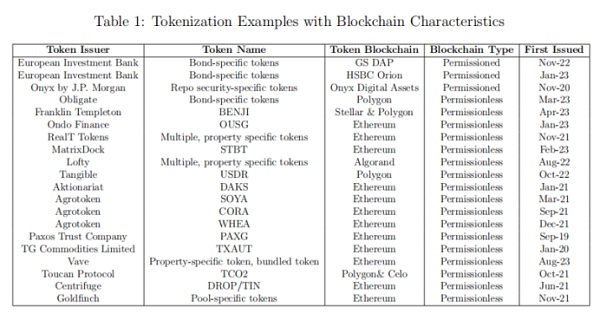
Another factor to consider is the underlying assets of the tokens. Underlying assets can be classified in various ways, such as on-chain assets and off-chain assets, intangible assets and tangible assets, etc. Off-chain underlying assets exist independently of the crypto market and can be tangible (such as real estate and commodities) or intangible (intellectual property and traditional financial securities). Tokenizing off-chain/underlying assets typically involves an off-chain custodian, such as a bank, to assess the value of the underlying assets and provide custody services. Tokenizing on-chain/crypto assets requires the inclusion of smart contracts to provide custody and asset evaluation for the crypto assets.
The last factor to consider is the redemption mechanism. Similar to some stablecoins, token issuers allow token holders to redeem their tokens for underlying assets. This redemption mechanism connects the crypto market with the underlying asset market. Additionally, tokenized assets can also be traded on secondary markets such as centralized crypto exchanges and DeFi exchanges. Although some security token offerings involving other on-chain debts or equities do not include redemption mechanisms, they still grant token holders other rights such as cash flow disposal rights related to their underlying assets.
II. Current market size of tokenization and categories of tokenized assets
According to publicly available information, we estimate that as of May 2023, the market size of tokenization on permissionless blockchains is $2.15 billion. These assets are typically issued by DeFi protocols like Centrifuge and traditional financial companies like LianGuaixos. Due to the different tokenization schemes, there is no unified standard, making it difficult to obtain a comprehensive set of data. Therefore, we will showcase the thriving development of tokenization in DeFi using publicly available data from the DeFiLlam platform. As shown in Table 1, since June 2022, the total value locked (TVL) in the entire DeFi market has remained relatively stable, while Table 2 shows that since July 2021, the TVL of real-world assets (RWA) has been continuously growing compared to similar asset classes or the entire DeFi market. Many new tokenization projects have recently been announced, involving various categories of underlying assets such as agricultural products, gold, precious metals, real estate, and other financial assets.
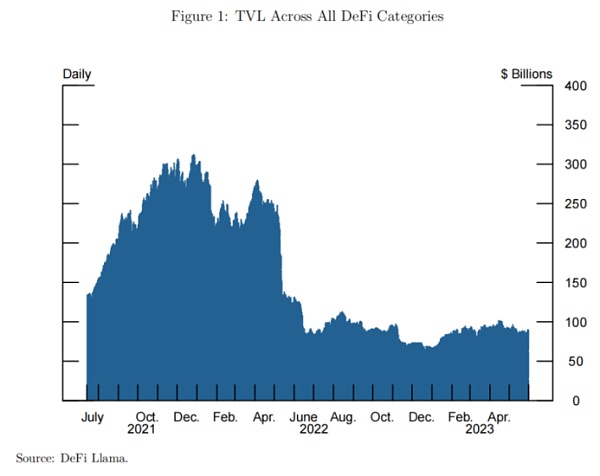

Recently, a typical tokenization project involves agricultural products like SOYA, CORA, and WHEA, which are references to soybeans, corn, and wheat respectively. The project is a pilot program initiated by Santander Bank and crypto company Agrotoken in Argentina in March 2022. By embedding the underlying asset’s recourse rights in the token and building the infrastructure for verifying, processing transactions, and redemption, Santander Bank is able to accept these tokens as collateral for loans. Santander Bank and Agrotoken have expressed their desire to promote the tokenization of commodities in larger markets such as Brazil and the United States in the future.
Another category of underlying assets for tokenization is gold and real estate. As of May 2023, the market size of tokenized gold is approximately 1 billion US dollars. Two types of tokenized gold account for 99% of the market share, namely LianGuaix Gold (LianGuaiXG) issued by LianGuaixos Trust ComLianGuainy and Tether Gold (XAUt) issued by TG Commodities Limited. Both issuers set the token unit equivalent to one ounce of gold, which is stored by the issuers themselves in accordance with the standards set by the London Bullion Market Association (LBMA). LianGuaiXG can be redeemed for equivalent US dollars, while XAUt is redeemed through the issuer selling it on the Swiss gold market. Overall, the two models are basically the same and have the same value as gold futures.
Compared to commodities like agricultural products and gold, real estate as an underlying asset faces challenges such as standardization difficulties, weak circulation, and difficulty in evaluating value. It also faces more complex legal and tax issues. These pose greater challenges to the tokenization of real estate. Real Token Inc. (RealT) is a project that tokenizes the equity of residential properties by collecting them and tokenizing the shares of limited liability companies (LLCs) that independently hold each property. The properties themselves are not tokenized, but the shares of the LLC companies are, allowing different investors to co-own each property. The project mainly provides a way for international investors to invest in US real estate and receive rental income as returns. As of September 2022, RealT has tokenized 970 properties with a total value of 52 million US dollars.
The tokenization of financial assets involves securities, bonds, and underlying assets like ETFs. Unlike directly holding securities, the price of tokenized securities may differ from the price of the securities themselves. On the one hand, this is because tokens can be traded 24/7, and on the other hand, it is based on the programmability of tokens and their composability with DeFi, which can bring different liquidity to tokens. We use table 345 to show the differences in the prices of META securities and the corresponding security token prices of MEAT, as well as the trading volume (based on Bittrex FB).
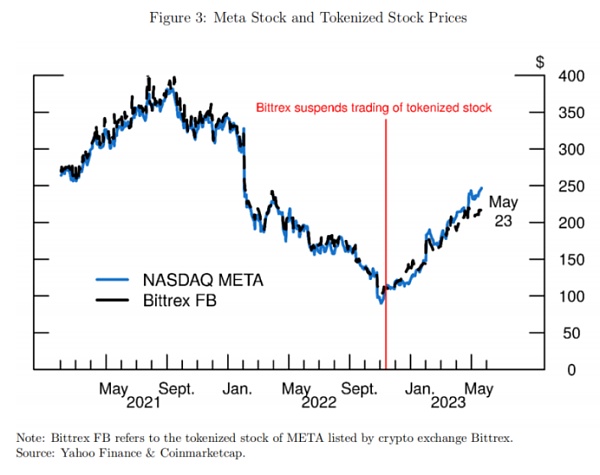
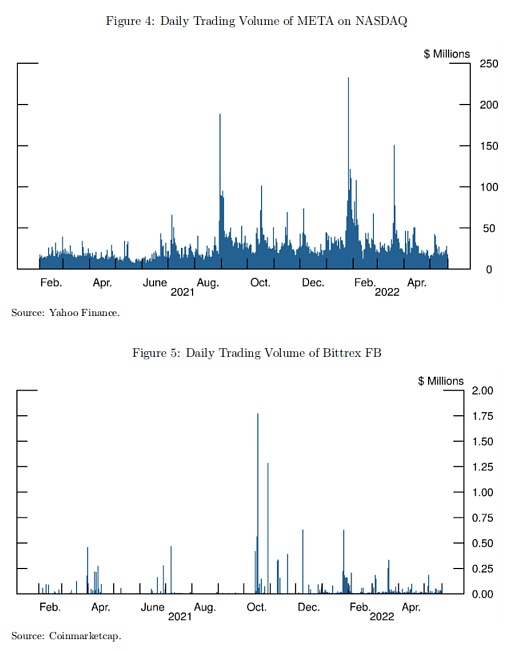
Traditional compliant exchanges can tokenize securities, or tokens can be directly issued on the blockchain. Akionariat, based in Switzerland, provides tokenization services for Swiss companies. US listed companies such as Amazon (AMZN), Tesla (TSLA), and Apple (AAPL) have tokenized securities traded on Bittrex and FTX.
In early 2023, Ondo Finance issued tokenized funds, with the underlying assets of these tokenized funds being US Treasury bonds and corporate bond ETFs. The shares of these tokenized funds represent the shares in the corresponding ETF. In addition, Ondo Finance holds a small amount of stablecoins as liquidity reserves. Ondo Finance serves as the manager of the tokenized fund, Clear Street serves as the broker and custodian of the fund, and Coinbase serves as the custodian of the stablecoins.
III. Benefits of Tokenization
Tokenization brings many benefits, including allowing investors to enter markets that were previously inaccessible due to high investment thresholds. For example, tokenized real estate allows investors to purchase a small fraction of a specific commercial building or residential property, which is different from investment tools such as Real Estate Investment Trusts (REITs) that offer portfolios of real estate.
The programmability of tokens and the ability to use smart contracts allow for additional functionalities to be embedded in tokens, which may also benefit the underlying asset market. For example, liquidity savings mechanisms can be applied to token settlement, which are difficult to implement in the real world. These blockchain features may lower the entry barriers for a wide range of investors, making the market more competitive and liquid, and enabling better price discovery.
Tokenization can also facilitate lending by using tokens as collateral, as discussed earlier in the case of tokenized agricultural products, because directly using agricultural products as collateral would be costly or impractical. In addition, settlement of tokenized assets is more convenient compared to underlying real-world assets or financial assets. Traditional securities settlement systems, such as Fedwire Securities Services and the Depository Trust and Clearing Corporation (DTCC), generally settle transactions on a gross or net basis throughout the settlement cycle, usually one business day after the transaction.
ETFs are the closest financial instruments to tokenized assets, and existing empirical evidence suggests that tokenization can improve the liquidity of underlying asset markets. The academic literature on ETFs demonstrates a strong positive correlation between ETFs and the liquidity of underlying assets, and finds that additional trading activity in ETFs leads to higher information exchange/circulation of underlying assets in ETFs. For tokens, similar mechanisms to ETFs imply that greater liquidity in the cryptocurrency market may be more advantageous for the value discovery of underlying assets.
IV. The Impact of Tokenization on Financial Stability
The tokenization market with a size of less than one billion dollars is relatively small compared to the overall cryptocurrency market or traditional financial market, and it does not pose a systemic financial stability issue. However, if the tokenization market continues to grow in terms of quantity and scale, it may bring risks to both the cryptocurrency market and the traditional financial system in terms of financial stability.
In the long run, the redemption mechanisms established between the tokenized asset ecosystem and the traditional financial system in tokenization may have potential impacts on financial stability. For example, in a large enough scale, the emergency sell-off of tokenized assets may affect the traditional financial market, as the price discrepancy in the cryptocurrency market provides market participants with arbitrage opportunities to redeem tokenized assets with underlying assets. Therefore, there may be a need for a mechanism to address value transmission in both of these markets.
In addition, tokenized assets may face issues due to the illiquidity of underlying assets. Examples may include real estate or other assets with poor liquidity. This issue is also discussed in the academic literature on ETFs, where there is a strong correlation between the liquidity, price discovery, and volatility of underlying assets in ETFs.
Another financial stability risk lies in the token asset issuers themselves. Tokenized assets with redemption options may encounter similar problems as asset-backed stablecoins like Tether. Any uncertainty about underlying assets (especially the lack of disclosure and information asymmetry of issuers) may increase the incentive for investors to redeem underlying assets, thereby triggering the sell-off of tokenized assets.
This transmission of liquidity may also be exacerbated by the characteristics of the cryptocurrency market. Cryptocurrency exchanges allow for continuous trading of crypto assets 24/7, while most underlying asset markets are only open during business hours. The mismatch in trading hours may have unpredictable effects on investors or institutions in certain situations.
For example, tokenized asset issuers with redemption options may face token sell-offs during weekends, as the underlying assets are held off-chain and traditional markets are closed for trading on weekends, making it impossible for redeemers to quickly obtain the underlying assets. This situation may worsen further, as the decline in the value of tokenized assets may threaten the solvency of institutions that hold a significant portion of the assets on their balance sheets. Moreover, even if institutions can obtain liquidity from traditional markets, they may have difficulty injecting it during the period when traditional markets are closed.
Therefore, a large-scale sell-off of tokenized assets may quickly reduce the market value of holding asset institutions and issuers, affecting their borrowing capacity and thereby impacting their ability to repay debts. Another example may be related to the automatic margin call mechanism of DeFi exchanges, which triggers liquidation or token redemption requirements, and this may have unpredictable effects on the underlying asset market.
With the development of tokenization technology and tokenized asset markets, tokenized assets themselves may become underlying assets. Considering that the prices of cryptographic assets are more volatile than similar underlying assets in the real world, the price fluctuations of these tokenized assets may transmit to traditional financial markets.
As the size of the tokenized asset market continues to expand, traditional financial institutions may participate in various ways, either by directly holding tokenized assets or holding tokenized assets as collateral. Examples of this may include Santander Bank using tokenized agricultural products as collateral to provide loans to farmers. As mentioned above, we also see cases like Ondo Finance tokenizing U.S. government money market funds.
In addition, although similar in nature to JPMorgan’s use of Money Market Fund (MMF) equity as collateral for repurchase and securities lending transactions, Ondo Finance’s actions may have a more profound impact on traditional financial markets. Ondo Finance’s tokens are deployed on the public blockchain Ethereum rather than the institution’s own private permissioned blockchain, which means that Ondo Finance has no control over how users and DeFi protocols interact. As of May 2023, Ondo Finance’s tokenized funds account for 32% of the entire tokenized asset market. According to DeFiLlama, Ondo Finance is the largest tokenization project in this category, and its token OUSG can also serve as collateral for the lending protocol Flux Financ.
Finally, similar to the role of asset securitization, tokenization may package high-risk or illiquid underlying assets into secure and easily tradable assets, which may bring higher leverage and risk exposure. Once the risk is exposed, these assets may trigger systemic events.
Conclusion
This article aims to provide an overview of asset tokenization and discuss the potential benefits and risks to financial stability. Currently, the scale of asset tokenization is very small, but tokenization projects involving various types of underlying assets are under development, indicating that asset tokenization may occupy a larger portion of the crypto ecosystem in the future. Among the potential benefits of tokenization, the most prominent is the reduction of barriers to entry into markets that were previously inaccessible and the improvement of liquidity in such markets. The financial stability risks brought about by asset tokenization mainly lie in the interconnections between tokenized assets in the crypto ecosystem and the traditional financial system, which may transmit risks from one financial system to another.
Appendix: Information on Some Asset Tokenization Projects
Digital Bonds Issued by the European Investment Bank
The European Investment Bank has issued multiple blockchain bond products. The first bond was issued through the HSBC Orion platform using a combination of private and public blockchains, with a total size of 50 million pounds. The blockchain serves as a record of bond ownership and manages floating rate instruments and bond lifecycle events. The bond will be held in the form of a digital account via the HSBC Orion platform.
The second bond was issued through Goldman Sachs’ private blockchain GS DAP, with a total size of 100 million euros and a term of 2 years. The bond is represented in the form of security tokens, and investors can purchase them using fiat currency. Goldman Sachs Bank Europe, Santander Bank, and Société Générale act as joint managers and settle with the issuer in the form of CBDC. These tokens are provided by the Banque de France and the Central Bank of Luxembourg. Société Générale Securities Services (SGSS Luxembourg) serves as the custodian of on-chain assets, and Goldman Sachs Europe serves as the custodian of CBDC accounts.
The characteristic of this bond is T+0 instant settlement. Secondary trading can only be conducted over-the-counter and settled off-chain using fiat currency. Bond interest is paid in fiat euros, and Goldman Sachs Europe acts as the payment agent, distributing these funds to bondholders.
Morgan Stanley’s Onyx platform
Morgan Stanley’s Onyx platform has the ability to tokenize assets and conduct encrypted asset transactions. Onyx is based on a permissioned blockchain and primarily serves institutional clients, such as providing cross-currency transactions for digital yen and digital new dollar, and providing services for the issuance of Singapore government bonds. In the future, Morgan Stanley stated that it will perform ledger transactions for US Treasury bonds or money market funds on the Onyx platform.
The Onyx platform also completes the settlement of intraday repurchase transactions between Morgan Stanley brokers and bank entities. Both the collateral and cash portions of repurchase transactions can be settled using the Onyx platform. For cash transactions in repurchase transactions, settlement is done using their JPM Coin, a blockchain-based banking account system. Since its launch in 2020, the platform has generated $300 billion in revenue.
Obligate
Obligate is a blockchain-based debt tokenization protocol that allows companies to issue bonds and commercial bills directly on the blockchain. The protocol supported the issuance of euro-denominated bonds by German industrial company Siemens on the Polygon network, with a total bond size of $64 million. Obligate also provided support for Swiss commodity trading company Muff Trading AG. When investors purchase these bonds, they receive ERC-20 tokens in their crypto wallets. According to their website, all future bonds will be denominated in USDC, and issuers must go through the KYC process.
Investors will be able to access Obligate through existing crypto wallets. For each investment, investors hold corresponding eNotes (ERC-20) tokens, which have the right to receive payments upon maturity or collateral in case of default.
Franklin Templeton
US asset management company Franklin Templeton offers tokenized US government money market funds based on the Stellar and Polygon public blockchains. Investors can purchase Benji tokens, with each token representing a share in the tokenized fund. The target of each share is to maintain a stable $1 share price and can be redeemed at any time. Share ownership is recorded on the proprietary system of the Stellar blockchain network.
The tokenized fund is 92.5% sourced from US institutions, with the remaining portion in cash. Investors can purchase through the Benji Investments application. The tokenized fund currently manages assets worth over $272 million.
Ondo Finance
Ondo Finance offers several tokenized fund products, including OUSG, OSTB, OHYG, and OMMF. The underlying assets of the tokenized funds are Blackrock US Treasury ETF, PIMCO Enhanced Short Maturity Active ETF, Blackrock iBoxx High Yield Corporate Bond ETF, and American Fund. The earnings of OMMF tokens are airdropped daily to token holders, while the earnings of other tokens (like OHYG) are automatically reinvested in related assets. Token holders can receive traditional fund accounting reports from third-party service providers to verify fund assets.
Tokens can be redeemed daily but settlement may take several days. If the fund has USD on hand, redemption occurs immediately. If not, the fund will sell ETF shares, transfer USD from Clear Street to Coinbase, convert USD to USDC on Coinbase, and then pay USDC to token holders.
RealT
Real Token Inc. (RealT) tokenizes ownership rights of residential properties by collecting them. Each property is independently held by a limited liability company (LLC), and the properties themselves are not tokenized but rather the shares of the LLC companies. Therefore, the shares of each company that owns properties are securitized and can be jointly held by investors. The project primarily provides international investors with a way to invest in US properties and receive rental returns. As of September 2022, RealT has tokenized 970 properties with a total value of $52 million.
Legally, RealT is a company registered in Delaware called Real Token LLC. The existence of this entity simplifies the process of tokenizing property by placing each property under a series of LLC companies and offering share ownership to earn returns.
RealT tokens can be used as collateral for the RMM DeFi lending protocol based on Aave V2. So far, only non-US users can access the RMM protocol and borrow the stablecoin DAI.
MatrixDock
MatrixDock issues its stablecoin (STBT), with each stablecoin anchored to 1 USD. The stablecoin is backed by US Treasury bonds with maturities of no more than 6 months and repurchase agreements. STBT can be minted or redeemed, and users must deposit USDC/USDT/DAI. Once the purchase of underlying assets is “confirmed,” the deposited USDC/USDT/DAI will be minted into STBT tokens. Redemption can be done through the MatrixDock application or by transferring STBT to the issuer’s dedicated address, with a T+4 deadline (only on New York business days). If holders redeem STBT before maturity, the execution price is calculated by dividing the settlement price of the government bonds by the fair market value (FMV) of the previous day.
Lofty
Lofty, based on the Algorand blockchain, will tokenize US real estate. Its operation is very similar to RealT, which means that after the property is transferred from the seller to Lofty, Lofty will place each property in a separate LLC company and tokenize the shares of the LLC company. Holding these tokens generates income from rental income and property appreciation. Since the underlying assets are a legal right and not the underlying assets themselves, there is unlikely to be a way to redeem them.
Tangible
Tangible is an NFT marketplace for real-world assets, allowing users to convert wine, gold bars, watches, and real estate into NFTs. Real-world assets are stored and secured in Tangible’s storage facilities. Users can purchase NFTs with the platform’s native stablecoin (Real USD, primarily supported by real estate interest income, with an expected APY between 10% and 15%) or tokens such as DAI. Only when a holder owns all the shares of an NFT can the underlying assets be redeemed.
Aktionariat
Aktionariat is a legally compliant digital platform limited to Switzerland. The Aktionariat platform provides tools for tokenizing shares for other companies and enables their trading. As Aktionariat has the ability to hold and trade tokenized stocks as well as traditional stocks, the price of the stocks will depend on the total supply, including listed stock shares, and the valuation of the company. Aktionariat maps and updates the shareholder register in real-time by tracking transaction addresses on the blockchain and addresses stored in off-chain databases. However, token transfers may not necessarily result in changes to the register due to the distinction between shareholders and token holders. Companies can also revert to traditional share ownership by repurchasing their tokens from shareholders and “burning” them.
Agrotoken
Agrotoken offers a solution for tokenizing agricultural products such as soybeans, corn, and wheat, with each token representing 1 ton of the underlying commodity. The expiration date of the commodity can also be marked as 30, 60, or 90 days, or renewed up to the maximum contract date. Exporters or collectors will ensure grain reserve certificates through oracles. The protocol operates on the Ethereum public blockchain, and each token is an ERC-20 token.
The project is a pilot program launched by Santander Bank and the crypto company Agrotoken in Argentina in March 2022. By embedding the right to recourse to the underlying commodity in the tokens and building infrastructure for verifying and processing transactions and redemptions, Santander Bank is able to accept these tokens as collateral for loans.
Through a partnership with Visa, Agrotoken has created a bank card accepted by 80 million stores and businesses associated with tokenized agricultural products projects. The company is effectively connecting Argentine farmers and exporters with the global business network that holds surplus food.
LianGuaixos Trust
LianGuaixos is a financial institution specializing in blockchain infrastructure and payment systems. It is also the custodian of many encryption projects, such as the stablecoin USDP and tokenized gold LianGuaix Gold (LianGuaiXG). LianGuaiXG operates only on the Ethereum blockchain and is available for settlement around the clock, accounting for about half of the tokenized gold market. One LianGuaiXG token is equivalent to one ounce of gold and can be exchanged for physical gold itself, as well as the rights to gold equity/credit, or sold directly for US dollars through the LianGuaixo platform. LianGuaixos is regulated by the New York State Department of Financial Services.
TG Commodities Limited
TG Commodities Limited is the issuer of Tether Gold (XAUt) and is based in London. Legally, it is not the same entity as Tether Limited (USDT), the stablecoin issuer based in Hong Kong, but they will be treated as the same issuer. One XAUt is equivalent to one ounce of gold and can be exchanged for physical gold itself or the legal currency obtained after selling the physical gold on the Swiss gold market. All XAUt tokens are backed by physical gold, and holders can search for specific gold bars associated with their XAUt on the Tether Gold website. Redemptions can only be made for whole gold bars ranging from 385 to 415 ounces.
Toucan Protocol
The Toucan Protocol allows users who have carbon credit quotas in carbon registries to tokenize them and enable trading. The tokenized carbon credit quota is called TCO2s and is programmed as NFTs, which can be differentiated by adding additional names such as TCO2-GS-0001-2019 to identify the projects and specific situations of the carbon credit quotas. Toucan also manages two liquidity pools: the base carbon pool and the nature-based carbon pool, to enhance liquidity and aggregate similar carbon credits. The nature-based carbon pool only accepts TCO2 tokens generated from nature-based projects.
Centrifuge
Centrifuge is an open DeFi protocol and a real-world asset marketplace. Owners of real-world assets act as originators to create asset pools fully collateralized by real-world assets. The protocol is not limited to asset types and has multiple categories of asset pools, such as mortgage loans, trade invoices, microloans, and consumer finance, etc. Furthermore, Centrifuge can be integrated into other DeFi protocols, for example, it holds most of the RWA assets in MakerDAO.
The tokenization of real-world assets is initiated and established by asset originators, and each asset pool is connected to a Special Purpose Vehicle (SPV) that acquires legal ownership of the assets from the asset originators to separate the assets of the SPV from the business of the asset originators. Real-world assets are tokenized as NFTs and associated with off-chain data. Investors deposit stablecoins (usually DAI) into the asset pool, and in return, they receive two types of tokens representing the asset pool based on their risk preference: TIN and DROP tokens. TIN and DROP tokens can be redeemed periodically, and investors’ returns come from the fees paid by borrowers obtaining financing from the asset pool. Investors can also receive rewards in the form of the platform token CFG.
Goldfinch
Goldfinch is a decentralized lending protocol that provides encrypted loans for fully collateralized off-chain assets. The protocol has three main participants: investors, borrowers, and auditors. Investors can also support the development of the protocol by providing funds to the Goldfinch Reserve.
Borrowers are off-chain borrowing entities who propose transaction terms regarding the loan amount in the protocol, known as loan pools. Investors can directly provide funds to the lending pool or indirectly provide funds to the protocol through the automatic allocation process in the protocol. Investors can redeem their tokens on specific dates, such as once a quarter.
End of the article
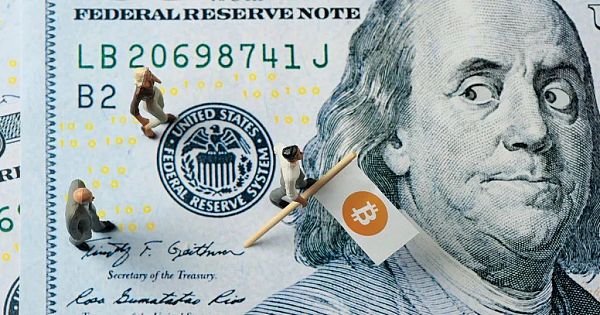 (https://talkbusiness.net/2022/08/fed-governor-banks-looking-to-get-into-crypto/)
(https://talkbusiness.net/2022/08/fed-governor-banks-looking-to-get-into-crypto/)
We will continue to update Blocking; if you have any questions or suggestions, please contact us!
Was this article helpful?
93 out of 132 found this helpful
Related articles
- What is Bastion, the encryption product that received a $25 million seed round lead by a16z?
- Evening Must-Read | How AI Reshapes the Cryptocurrency and DeFi World
- LianGuai Morning News | Musk considers charging all Twitter users
- Rollups are competing fiercely. Will a monopolistic Rollup emerge from the competition?
- Ethereum Merger One Year Anniversary What Changes Have Occurred in the MEV Supply Chain
- Lawsuit tug-of-war escalates, SEC requests investigation into Binance.US assets
- Celebratory Token2049 and Serene Singapore






